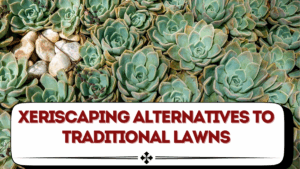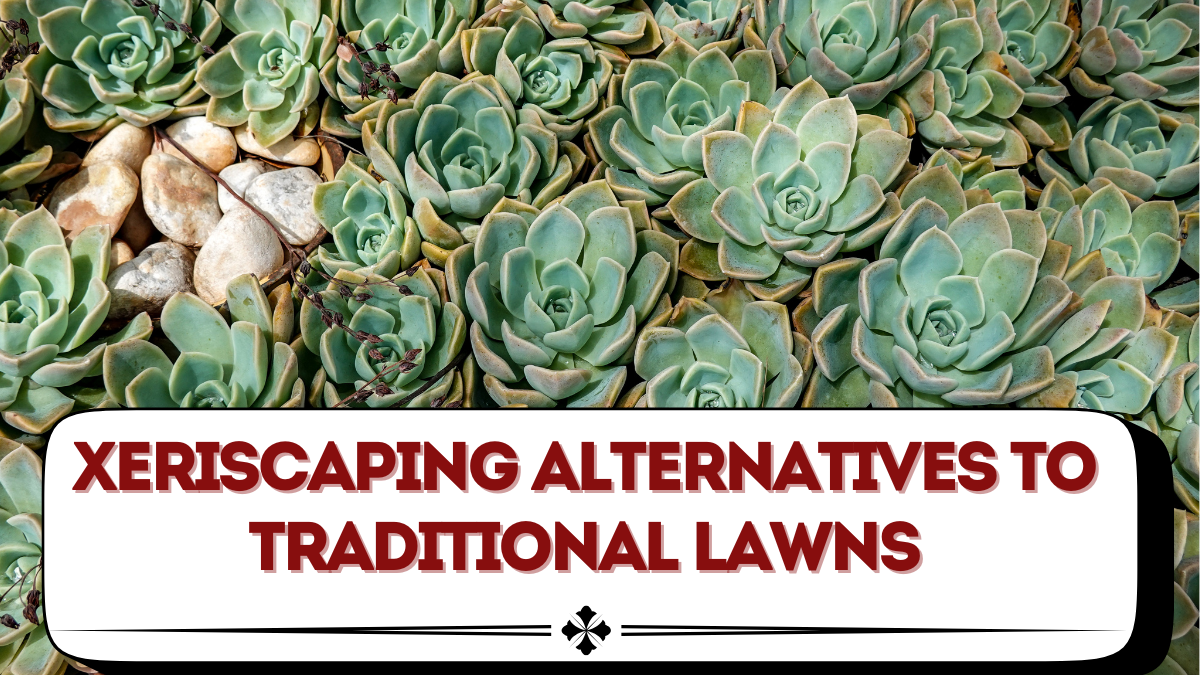Traditional lawns may look beautiful, but they demand enormous amounts of water, fertilizer, and ongoing maintenance. In many regions where water scarcity is becoming a reality, homeowners are searching for sustainable solutions that still offer curb appeal. This is where xeriscaping lawn alternatives come into play. Xeriscaping, derived from the Greek word “xeros” meaning dry, is a landscaping approach designed to reduce or eliminate the need for irrigation.
In 2025, xeriscaping is no longer a niche trend but a mainstream solution embraced by eco-conscious homeowners. By replacing traditional turf with drought-friendly plants, decorative stone, and low-water landscaping designs, you can create a stunning yard that thrives even in the driest conditions.

Why Xeriscaping is Growing in Popularity
Water shortages, rising utility costs, and climate change have forced homeowners to rethink how they manage outdoor spaces. Lawns consume nearly 30–60% of household water in many areas, especially in arid regions. Xeriscaping directly addresses this problem by introducing waterwise gardens that not only save resources but also require less effort to maintain.
Another reason for the growing popularity of xeriscaping is the variety of design options. Unlike plain grass lawns, xeriscaped yards can include colorful native flowers, ornamental grasses, decorative gravel, and even artificial turf for a modern look. Homeowners are realizing they can have a low-maintenance, eco-friendly yard without sacrificing beauty.
Core Principles of Xeriscaping
Successful xeriscaping is not just about replacing grass with rocks. It’s a design philosophy based on several guiding principles that ensure sustainability and functionality.
The key principles include:
-
Water Conservation – Use drought-tolerant plants and efficient irrigation methods.
-
Soil Improvement – Enrich soil with compost to retain moisture.
-
Practical Plant Selection – Choose native species adapted to the local climate.
-
Efficient Irrigation – Install drip irrigation or soaker hoses instead of sprinklers.
-
Mulching – Cover soil with mulch to reduce evaporation and suppress weeds.
-
Maintenance Planning – Design for minimal upkeep with low-maintenance plants.
By following these principles, xeriscaping ensures a yard that looks appealing while reducing water usage significantly.
Popular Xeriscaping Lawn Alternatives
There are multiple ways to implement xeriscaping, depending on your climate, budget, and aesthetic preferences.
Some popular alternatives include:
-
Native Plant Gardens – Use region-specific plants that thrive naturally without extra water.
-
Ornamental Grasses – Add movement and texture with low-water grasses like fountain grass or blue fescue.
-
Gravel or Stone Yards – Replace grass with decorative stones, pebbles, or decomposed granite.
-
Artificial Turf – Modern synthetic grass offers a green look without irrigation.
-
Succulent Beds – Perfect for dry regions, succulents store water and come in striking shapes.
-
Tapestry Lawns – A mix of low-growing ground covers like thyme and clover instead of traditional turf.
Comparing Xeriscaping Options
| Lawn Alternative | Water Usage | Maintenance Level | Visual Appeal |
|---|---|---|---|
| Native Plant Garden | Very Low | Medium | High, colorful year-round |
| Ornamental Grasses | Low | Low | Textured, natural look |
| Gravel / Stone Yard | None | Very Low | Clean, modern style |
| Artificial Turf | None | Very Low | Always green, uniform |
| Succulent Beds | Very Low | Low | Unique, decorative shapes |
| Tapestry Lawn | Low | Medium | Natural, eco-friendly |
This table shows that xeriscaping can fit any style preference, whether you want colorful plants, a modern stone design, or a lush green look without water dependency.
Cost and Long-Term Benefits
While xeriscaping may require a higher upfront investment compared to seeding grass, the long-term savings are significant. Reduced water bills, minimal fertilizer use, and fewer lawn care tools result in lower maintenance costs. Over a five-year period, homeowners often save more money with xeriscaping than with traditional turf upkeep.
The environmental benefits are equally compelling. Xeriscaping supports pollinators, improves biodiversity, and reduces chemical runoff into waterways. For eco-conscious households, it is both a financial and environmental win.
Design Tips for a Successful Xeriscape
Practical design tips include:
-
Combine gravel walkways with clusters of drought-tolerant plants for visual balance.
-
Group plants with similar water needs together to optimize irrigation.
-
Use bold accents like boulders or pottery for focal points.
-
Mix different textures—succulents, grasses, and shrubs—for layered aesthetics.
-
Install rainwater harvesting systems to supplement irrigation.
A well-planned xeriscape doesn’t look barren or desert-like; instead, it becomes a living showcase of sustainable design.
FAQs
What is the biggest advantage of xeriscaping?
The primary advantage is water conservation, as xeriscaping can reduce outdoor water use by up to 70%.
Is xeriscaping expensive to install?
Initial costs can be higher than traditional lawns, but long-term savings on water and maintenance outweigh the expense.
Can xeriscaping work in rainy regions?
Yes, xeriscaping is not limited to dry climates. Native plants and proper soil design make it suitable for almost any region.
Do xeriscaped yards require zero maintenance?
Not completely. While xeriscapes need less care, occasional weeding, pruning, and soil care are still necessary.
Can I still have a green-looking lawn with xeriscaping?
Yes, artificial turf and drought-tolerant ground covers can provide a green lawn appearance without heavy water use.
Conclusion
The shift toward xeriscaping lawn alternatives reflects a growing need for sustainable, low-maintenance landscapes. By choosing drought-tolerant plants, efficient irrigation, and innovative design elements, homeowners can create yards that are both beautiful and water-wise. Whether you opt for native plant gardens, gravel yards, or artificial turf, xeriscaping offers long-term savings, environmental benefits, and endless design possibilities. In 2025, xeriscaping is no longer just an alternative—it’s the future of smart landscaping.
Click here to know more.
